

Kansas Multi- Tier System of Supports. RTI (Part 5): A Closer Look at Tier 3. RTI (Part 4): Putting It All Together. *Note: This is the fourth module in a series on RTI.
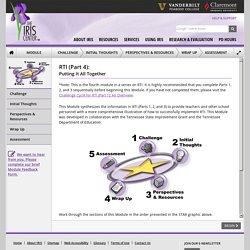
It is highly recommended that you complete Parts 1, 2, and 3 sequentially before beginning this Module. If you have not completed them, please visit the Challenge Cycle for RTI (Part 1): An Overview. This Module synthesizes the information in RTI (Parts 1, 2, and 3) to provide teachers and other school personnel with a more comprehensive illustration of how to successfully implement RTI. This Module was developed in collaboration with the Tennessee State Improvement Grant and the Tennessee Department of Education. Work through the sections of this Module in the order presented in the STAR graphic above. RTI (Part 3): Reading Instruction. This Module illustrates different research-based reading strategies that may be used with the response-to-intervention model to improve reading skills.
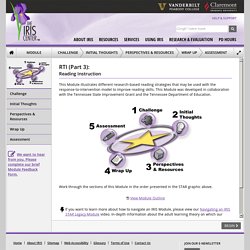
This Module was developed in collaboration with the Tennessee State Improvement Grant and the Tennessee Department of Education. Work through the sections of this Module in the order presented in the STAR graphic above. View Module Outline If you want to learn more about how to navigate an IRIS Module, please view our Navigating an IRIS STAR Legacy Module video. In-depth information about the adult learning theory on which our Modules are based is available on the IRIS & Adult Learning Theory page.
Copyright 2015 Vanderbilt University. RTI (Part 2): Assessment. This Module explores in detail the assessment procedures integral to RTI.

It also outlines how to use progress monitoring data to determine if a student is meeting the established performance criteria or if more intensive intervention is needed. This Module was developed in collaboration with the Tennessee State Improvement Grant and the Tennessee Department of Education. Work through the sections of this Module in the order presented in the STAR graphic above. RTI (Part 1): An Overview. This Module outlines the differences between the IQ-achievement discrepancy model and the Response-to-Intervention (RTI) approach.

It also offers a brief overview of each tier in the RTI model and explains its benefits. This Module was developed in collaboration with the Tennessee State Improvement Grant and the Tennessee Department of Education. Work through the sections of this Module in the order presented in the STAR graphic above. RTI Talks. National Center on Intensive Intervention. Search Results. Center on Response to Intervention. RTI Action Network. Specific Learning Disabilities. What IDEA '04 Says | Implications for ASHA Members | What ASHA is Doing | What Members Should Do What IDEA '04 Says IDEA '04 retained the definition of specific learning disability as included in previous versions of IDEA since 1975.
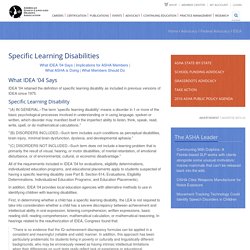
Specific Learning Disability ''(A) IN GENERAL. –The term 'specific learning disability' means a disorder in 1 or more of the basic psychological processes involved in understanding or in using language, spoken or written, which disorder may manifest itself in the imperfect ability to listen, think, speak, read, write, spell, or do mathematical calculations. " ''(B) DISORDERS INCLUDED. ''(C) DISORDERS NOT INCLUDED. All of the requirements included in IDEA '04 for evaluations, eligibility determinations, individualized education programs, and educational placements apply to students suspected of having a specific learning disability (see Part B, Section 614, Evaluations, Eligibility Determinations, Individualized Education Programs, and Education Placements).
Rtiroledefinitions. Response to Intervention (RTI) About RTI - Response To Intervention (RTI) - A Rhode Island Technical Assistance Project (RITAP) Site. Overview RTI is a process of determining appropriate support and interventions to supplement the core curriculum to meet the needs of all learners.
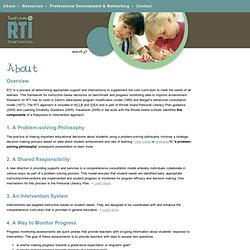
This framework for instruction bases decisions on benchmark and progress monitoring data to improve achievement. About RTI - Response To Intervention (RTI) - A Rhode Island Technical Assistance Project (RITAP) Site. The SLP and RtI: Part 2…The How — The Speech Bubble. If you read my first post, The SLP and RtI: Part 1…The What, you have a better idea of what RtI is and which tiers relate to certain speech interventions.
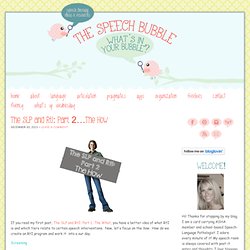
Now, let’s focus on the how. How do we create an RtI program and work it into a our day. Screening Usually, a student is brought up to your student problem solving team. As a team, and with your professional guidance, you may decide that this student needs to be screened for speech/language. When it comes to language you have a few more options. Results So what to do when you are done screening? If it was language you were looking at how did they do on their screening? RTI Strategies & Planning Tools. Speech Improvement Class Resources and Procedural Documents. This web page contains the streamlined forms used by San Diego Unified School District for the Speech Improvement Class.
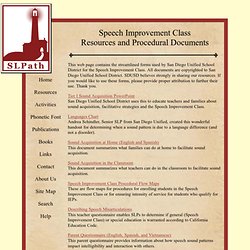
All documents are copyrighted to San Diego Unified School District. SDUSD believes strongly in sharing our resources. If you would like to use these forms, please provide proper attribution to further their use. Thank you. Tier I Sound Acquisition PowerPoint San Diego Unified School District uses this to educate teachers and families about sound acquisition, facilitative strategies and the Speech Improvement Class. Ehren, Barbara J. Barbara J.
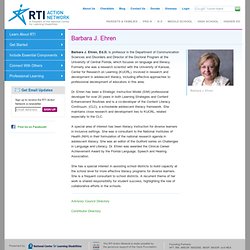
Ehren, Ed.D. is professor in the Department of Communication Sciences and Disorders and Director of the Doctoral Program at the University of Central Florida, which focuses on language and literacy. Formerly she was a research scientist with the University of Kansas, Center for Research on Learning (KUCRL), involved in research and development in adolescent literacy, including effective approaches to professional development of educators in this area. Dr. Ehren has been a Strategic Instruction Model (SIM) professional developer for over 20 years in both Learning Strategies and Content Enhancement Routines and is a co-developer of the Content Literacy Continuum.
(CLC), a schoolwide adolescent literacy framework. A special area of interest has been literacy instruction for diverse learners in inclusive settings. She has a special interest in assisting school districts to build capacity at the school level for more effective literacy programs for diverse learners. Response to Intervention (RTI) What is Response to Intervention?

The response to intervention (RTI) process is a multitiered approach to providing services and interventions to struggling learners at increasing levels of intensity. It involves universal screening, high-quality instruction and interventions matched to student need, frequent progress monitoring, and the use of child response data to make educational decisions. RTI should be used for making decisions about general, compensatory, and special education, creating a well-integrated and seamless system of instruction and intervention guided by child outcome data.
Mpdf_print. Rti_math_pg_042109.